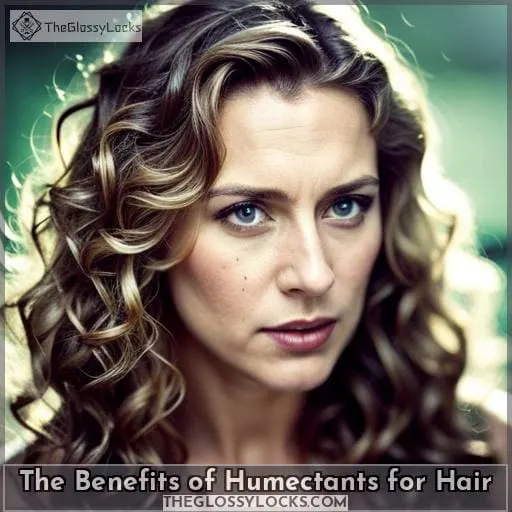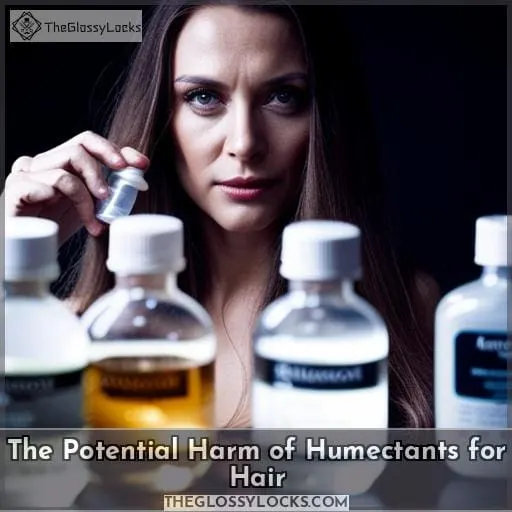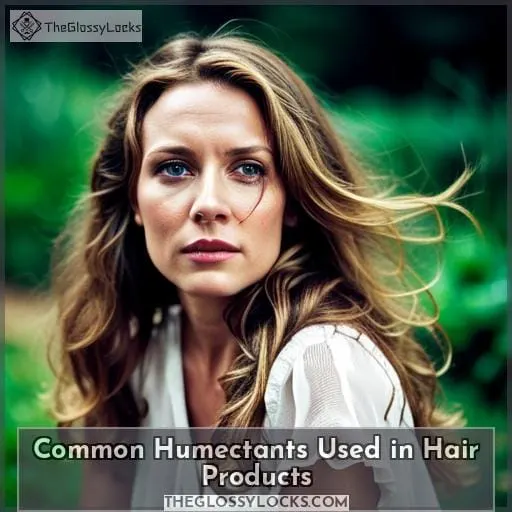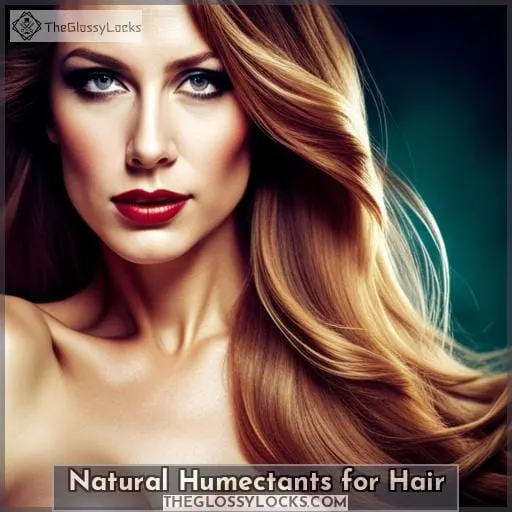This site is supported by our readers. We may earn a commission, at no cost to you, if you purchase through links.
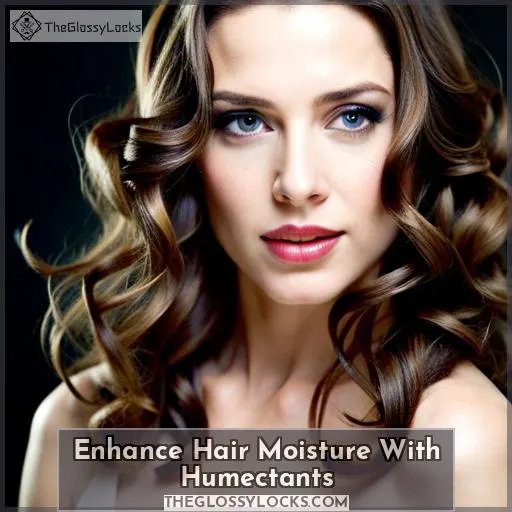 Are you struggling to keep your hair hydrated and moisturized? Humectants could be the answer. A humectant is a substance that attracts moisture from its surroundings, helping to rehydrate dry or damaged locks.
Are you struggling to keep your hair hydrated and moisturized? Humectants could be the answer. A humectant is a substance that attracts moisture from its surroundings, helping to rehydrate dry or damaged locks.
Take Sarah for example; her once-lush curls were becoming increasingly brittle due to an excess of heat styling, but after introducing humectants into her routine she noticed dramatic improvements in texture and shine within weeks!
With this article, we’ll explore how these powerful ingredients work their magic on our strands – so let’s get started!
Not only will we uncover the scientific explanation behind why they’re such effective hydrators, but also learn about common types of humectants used in hair products as well as potential harm they may cause.
We’ll even provide tips on how best to use them for healthy and bouncy locks, plus discover natural alternatives available out there too – so grab yourself a cup of tea because it’s time to dive deeper into understanding all things related to humidity concerns when using these magical ‘moisture magnets!
Table Of Contents
- Key Takeaways
- What Are Humectants?
- How Do Humectants Work?
- The Benefits of Humectants for Hair
- The Potential Harm of Humectants for Hair
- Common Humectants Used in Hair Products
- Understanding Humidity Concerns
- How to Use Humectants Effectively for Your Hair
- The Role of Emollients in Hair Care
- Natural Humectants for Hair
- Final Tips for Healthy and Hydrated Hair
- Conclusion
Key Takeaways
- Humectants attract and retain moisture for hair.
- Combining humectants with emollients and sealants is crucial.
- Humidity affects the effectiveness of humectants.
- Balancing moisture is essential for healthy hair.
What Are Humectants?
You can keep your locks feeling bouncy and healthy with moisture-attracting ingredients that draw in the needed hydration. Humectants are these special ingredients used to lock in moisture for skincare, food, and other products.
They work by attracting water molecules through hydrogen bonding, which is made possible due to polarity between substances like humectants and water.
Common natural humectants include propylene glycol, glycerin, and sorbitol, while biological ones are panthenol, hyaluronic acid, glycogen, glucose, fructose, keratin ethers, PEG-x, silicones, copolyols, sodium PCA, etc.
Humectants support hair health by providing proper hydration that helps retain its softness, shine, elasticity, resilience, bounce, texture, strength, porosity, manageability, and prevent breakage as well as split ends.
The effectiveness of using them depends on environmental humidity, so it’s important you use anti or pro humidifying agents accordingly. Additionally, incorporate emollients, sealers, conditioners, oils, proteins, butters, creams, serums, shampoos, lotions, balms, sprays, mists, etc.
How Do Humectants Work?
Humectants work by adsorbing rather than absorbing moisture, thanks to their polarity. Through hydrogen bonding, humectants draw in moisture molecules from the environment and bind them to their own structure, providing hair with necessary hydration.
Adsorption Vs Absorption
As you know, humectants adsorb moisture from the environment through hydrogen bonding instead of absorption, which involves sucking in moisture. Humidity levels have a significant effect on how effective humectants are for hair care.
In high humidity conditions, using too many humectant products can result in frizzy and sticky hair, while low humidity can cause dryness and potential damage to the hair strands. To maintain balanced moisture levels, it is important to use an effective combination of water, humectants, emollients, and sealants when applying them onto your locks.
Not only will this keep good hydration trapped, but it will also protect against any bad stuff that could potentially enter your locks, such as wind or harsh environmental elements like sun exposure or heat styling tools that may strip away essential oils needed for healthy growth and quality conditioning.
Achieving maximum benefits with minimal side effects requires careful selection of ingredients but should ultimately provide long-lasting results with less risk involved!
Polarity
The polarity of molecules like water and humectants is essential for hydrogen bonding, allowing them to attract and bind moisture.
Polarity allows humectants to act as a moisturizing agent, retaining moisture in hair.
Humidity levels in the environment can affect how effective these agents are; high humidity leads to frizz while lower dewpoint conditions require anti-humectant products for control.
Combining both types of product helps balance hair’s natural oils with environmental effects, protecting curls from damage due to overmoisturization or dryness caused by weather conditions.
Ultimately, understanding polarity between molecules enables us to create an effective system that keeps good moisture in and bad stuff out!
The Benefits of Humectants for Hair
Humectants are key ingredients used in hair care products to help maintain and balance moisture. By combining humectants with other effective moisturizers, you can achieve the best results for your individual hair type and protect curls from environmental effects.
Humectants and moisture balance
Balancing the moisture in your hair with humectants can keep it healthy and reduce frizz. Humidity and weather protection are key for keeping hair hydrated, while products like glycerin or aloe vera offer an added layer of softness.
Anti-humectants help to lock in moisture when humidity is high, while emollients protect against dry air by creating a barrier over the cuticle.
Humectants and hair types
Knowing how to use the right humectants for your hair type can make a world of difference. Humectants help keep textured hair moisturized while controlling frizz in dry climates.
Natural humectants like Aloe Vera and Caprylic Capric Triglycerides are ideal for curly hair. They provide moisture without added oil or damage. Synthetic options, such as propylene glycol, sorbitol, and laureth-x, also work well when used correctly in combination with other products.
When using any form of humectant on the scalp or strands, it’s important to consider humidity levels.
Combining humectants for effectiveness
By combining humectants with other products, you can maximize the benefits and minimize the side effects for any hair type. Glycerin, hyaluronic acid, panthenol, and other ingredients help retain moisture in low humidity or protect from excessive moisture in high humidity.
Effective product layering ensures hydration is locked in while protecting against frizz and breakage. Humidity control also plays a role; use anti-humectant sealants to maintain proper levels of moisture retention when needed.
The Potential Harm of Humectants for Hair
It’s important to be aware of the potential harm that overusing humectants can cause for your hair. Humectants are effective at hydrating and moisturizing, but they must be used with caution or else you may end up with frizzy hair, breakage, and other issues.
Here are three key points to consider when using humectants:
- Understand the drawbacks of using too many humectants on your strands.
- Achieve a balance between moisture retention and scalp health.
- Take note of environmental humidity levels before applying products.
Humidity can drastically affect how much water is absorbed by hair strands, so it’s best to apply anti-humectant products like shea butter in dry conditions. On the other hand, natural emollients like coconut oil should only be used in humid environments.
It’s also important not to use too many ingredients, as this could lead to excessive hydration which will weigh down locks resulting in limpness or stickiness from product buildup.
Lastly, take precautions against heat damage, since high temperatures accelerate moisture loss from the cuticle layer, leading to split ends and brittleness over time if not treated properly!
Common Humectants Used in Hair Products
When it comes to hair products, humectants are essential ingredients. Synthetic options such as propylene glycol, glycerin, and sorbitol work alongside biological varieties like panthenol, hyaluronic acid, and glycogen for moisture-attracting effects.
Synthetic Humectants
Synthetic humectants, such as propylene glycol, PEG-x, and silicone copolyols, work to attract moisture in the air and bind it to your hair. These synthetic compounds have a variety of properties that make them suitable for use in skincare products as well as cosmetics.
They are able to hold onto more water than natural alternatives, making them beneficial for preventing frizz due to high humidity levels or dryness from low dew points. Furthermore, they help maintain healthy hair by providing protection against raised cuticles, which can lead to breakage when exposed for extended periods without proper hydration.
Synthetic humectants provide an option for those looking for an alternative solution that will keep their locks looking luscious all year round, despite changing weather conditions!
Biological Origin Humectants
Discovering the power of biological origin humectants, you can harness moisture-attracting ingredients like panthenol, hyaluronic acid, and glycogen to keep your hair looking healthy and vibrant.
Humectants from a natural source are highly effective for retaining moisture in low humidity environments.
Alpha-hydroxy acids derived from fruits such as apples, grapes, or citrus also have good moisturizing properties when used in skin or hair products.
Natural moisturizing agents, such as glycerin, allow water to penetrate the surface layers of the skin, so it is better hydrated over time while providing anti-inflammatory benefits too.
Hair hydration is key with biological humectants. They enable moisture retention, which helps maintain softness, elasticity, and volume even in high-temperature climates where other synthetic alternatives cannot compete!
In skincare applications, these natural substances, such as retinol and hyaluronic acid, aid in reducing wrinkles and fine lines by keeping cells plump due to their excellent water absorption qualities. This makes them an ideal choice for those wishing to achieve a youthful glowing complexion without resorting to harsh chemical treatments.
Understanding Humidity Concerns
Humidity has a direct impact on your hair. Whether you’re trying to protect curls from drying out or fight off frizz, understanding how humidity affects your locks is essential.
High humidity can leave the hair looking limp and weighed down, while low dew points lead to dryness and breakage. To achieve the perfect balance of moisture, it’s important to understand what role humectants play in this equation.
Humectants help keep good moisture in by attracting water molecules via hydrogen bonding. They also act as a protective barrier against environmental factors like wind and sun exposure that can cause damage over time if not managed properly.
There are several types of humectants available for use on different hair types. Some examples include propylene glycol, glycerin, sorbitol, panthenol, hyaluronic acid, glycogen, glucose, fructose, ethers (isoceteth-x & laureth-x), PEG – x (polyethylene glycol), silicone copolyols, sodium PCA, castor oil, shea butter, and coconut oil.
While these ingredients provide hydration when used correctly, they should be combined with emollients and sealant products to create an effective moisturizing system that preserves healthy curls without adding too much oil.
By monitoring air conditions such as temperature, relative humidity, dew point, or even indoor living spaces, you will be able to adjust accordingly with anti-humectant/sealing products needed for high/low levels respectively.
Properly managing product application begins with understanding how climate influences curl health.
How to Use Humectants Effectively for Your Hair
By carefully selecting and combining the right products, you can maximize the benefits of humectants while minimizing potential side effects.
- Understand humidity levels in both indoor and outdoor environments to better determine when to use humectants or anti-humectants for optimum results.
- Consider applying natural emollients like coconut oil, castor oil, and shea butter as part of a balanced moisturizing system. This system should include water and sealant products alongside humectants for maximum hydration techniques tailored specifically to curly hair needs.
- Utilize effective product combinations such as Aloe Vera Juice with Rice Water Protein or glycerin with propylene glycol. These combinations protect curls from environmental elements while providing elasticity by locking in moisture at low dew point conditions without adding excessive oils into the mix.
With this knowledge, coupled with proper application practices using quality ingredients, you are well on your way towards achieving healthy locks all year round!
The Role of Emollients in Hair Care
Nourish your hair with emollients, which protect it like a shield from environmental damage. Emollients are natural oils and butters that coat the hair shaft to lock in moisture. These help hydrate dry or damaged strands while making them smoother and more manageable.
They also help create bounciness for curls when used as part of the Curly Girl Method (CGM).
Unlike humectants, they don’t draw water into the cuticle, so there is less risk of frizz or dehydration due to air humidity levels being too low or high. Additionally, many of these ingredients have natural properties that nourish your scalp and promote healthy growth, such as Coconut Oil, Castor Oil, Shea Butter, Aloe Vera Juice, Rice Water Protein, Glycerin, et al.
To ensure full benefits, apply an emollient-based product directly after shampooing, then use humectant products afterwards if desired. This helps prevent excess buildup on the scalp without compromising its hydrating capabilities.
Natural Humectants for Hair
Using natural humectants like panthenol, hyaluronic acid, and glycogen helps your hair retain moisture for a long time. Aloe Vera is an excellent source of beneficial humectants that can be used as part of DIY recipes or added to products with product labels listing it among the ingredients.
Humidity management is essential when using these natural substances. In dry weather, they may draw too much water from their environment, leading to frizziness and breakage. Salicylic acid and urea are particularly helpful in retaining moisture while preventing buildup on the scalp or strands during high humidity months.
They also protect against seasonal effects that could lead to damage over time without proper hydration balance maintenance.
Knowing what’s included on product labels ensures you’ll get maximum benefit from the use of all-natural humectant ingredients.
Final Tips for Healthy and Hydrated Hair
To keep your hair healthy and hydrated, combine various products with balanced humectants for best results.
To make sure you have the perfect haircare regimen, consider these five tips:
- Monitor humidity levels in and around your home to ensure proper hydration maintenance.
- Use occlusives such as shea butter or coconut oil to control moisture loss from the skin and hair due to dry weather conditions.
- Take note of acne-prone areas on the scalp when selecting products since some humectants may increase sebum production, which can lead to breakouts over time if not controlled correctly.
- Research natural ingredients like aloe vera juice that have hydrating properties without adding any extra oils that could weigh down curls or cause buildup over time.
- Develop a haircare routine that includes pre-shampoo treatments, moisturizers, deep conditioners, leave-in conditioners, styling serums, etc.
With this combination of product selection, humidity control, and regular care, you’ll be able to maintain healthy locks no matter what season!
Conclusion
Did you know that more than 80% of people experience hair dryness at some point in their lives? Humectants can help protect hair from dryness and breakage by attracting and binding moisture molecules to the hair.
As an added benefit, they can also help volumize and nourish hair. However, it’s important to understand how to use humectants effectively to maximize their benefits and minimize potential harm.
Choose humectants based on your hair type and environmental conditions, and combine them with other products such as emollients and sealants for the best results. Natural humectants like Aloe Vera juice and rice water protein can be beneficial for curly hair.
Ultimately, using the right humectants can help you achieve healthy and hydrated hair.



